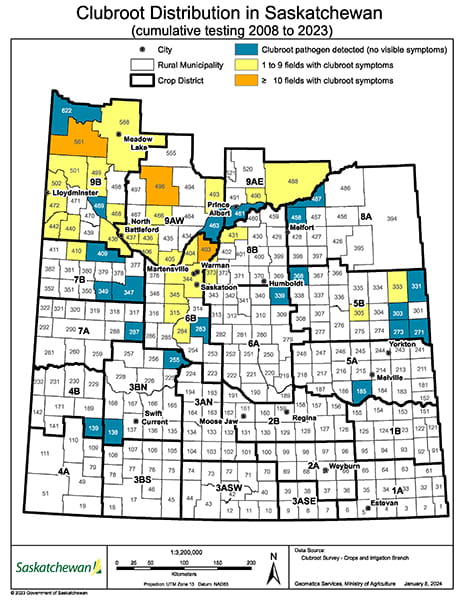By Ashley Kaminski, PAg, CCA, Crops Extension Specialist, Humboldt
March 2024
The Saskatchewan Clubroot Distribution Map has summarized clubroot findings in the province for 15 years now. The 2023 Clubroot Distribution map had minimal changes from previous years, as no new fields had visible clubroot symptoms and only one additional field was identified to have the pathogen through DNA testing in 2023. The distribution map encompasses data from multiple sources including in-field surveillance in high clubroot risk areas (188 samples), data from the Ministry of Agriculture’s permission-based general canola disease survey (182 samples), confirmed external reports of clubroot by producers and agrologists (92 samples) as well as the on-farm clubroot soil testing program put on by SaskCanola (92 samples). A total of 524 fields were examined in 205 rural municipalities in 2023.

as of January 2024
Although you may farm in an area where the distribution map shows low or no detection of symptoms or the pathogen, it is still a good idea to test your own fields and take advantage of programming available. The clubroot testing program from SaskCanola provides free soil testing to producers that want to test their land for the presence of the clubroot pathogen, even if visible symptoms are not present. There were 800 soil testing bags available for growers to use in the 2023 program. Bags for the clubroot testing program have been available through SaskCanola, Crops and Irrigation Branch (online sign-up), ministry regional offices, participating RMs, and SARM plant health technical advisors. If producers are interested in participating in upcoming years, reach out to your nearest regional office and talk to a crops extension specialist.
New disease testing program details are announced in July each year. SaskCanola recognizes the value of the disease testing programs for Saskatchewan canola growers and has promoted the program through the winter months. Watch for the program details to be released again in July for the 2024 growing season. Growers typically have until late-October to submit their samples. Soil testing for this program is relatively easy, especially if it’s done once the crop is harvested.
Growers can also get involved by providing permission to surveyors to access their land for pest monitoring surveys. Volunteer grower sign-up is greatly appreciated. When we have a comprehensive list of growers who have registered for the pest survey, it removes the need to actively find additional growers in the RM to seek permission to conduct the survey on their land.
Being aware of the pathogens on your land allows you to be proactive when planning crop rotations. In the instance of clubroot, crop rotation is the greatest tool to combat the disease, as spore levels decrease drastically with a greater than two-year crop rotation between susceptible crops. Crop rotation is an undervalued tool for many agronomic issues. Understandably, prices have a great influence on what you plant. Take some time to look at the 2024 Crop Planning Guide and see what other options make financial and agronomic sense in your region. Areas in the province with higher clubroot pathogen presence are mainly in the black and dark brown soil zones in the northwest part of the province. Potential alternative crop options for this area may include oats, lentils or peas. Other minor crops may be an option as well, and experimenting with them on small acres initially is a good way to test if they are a fit for your farm.
For more information on clubroot management, please contact the Agriculture Knowledge Centre at 1‑866‑457‑2377.
